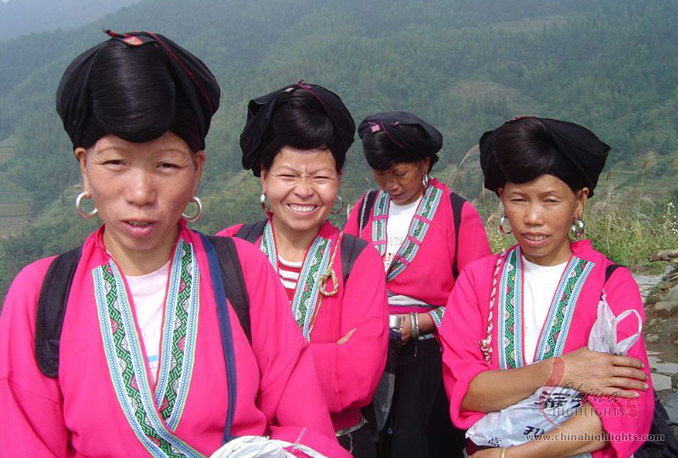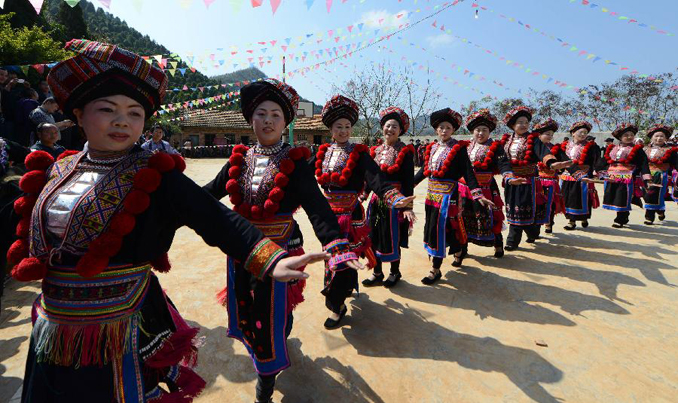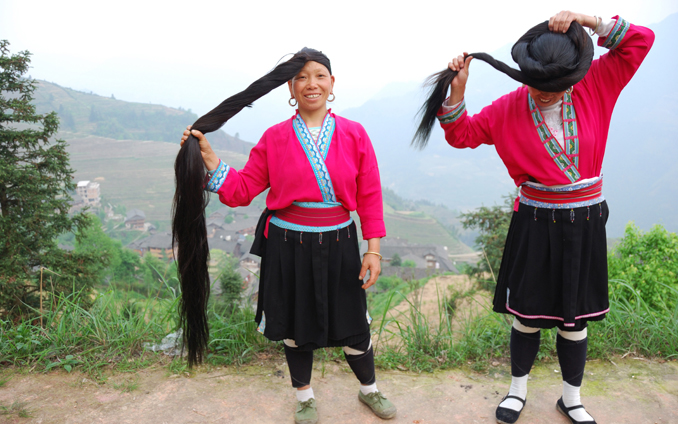Written by: Gulibaha
Posted on: March 03, 2015 | 
Guangxi Province
The Yao people have their own language, which belongs to the Miao-Yao sub-group of the Sino-Tibetan language family. As they are scattered in various directions, the Yao people speak different dialects of their language. Coexisting with people of the Han and Zhuang, the Yao people in different areas also speak Chinese or Zhuang language. Some can also speak languages of other ethnic peoples. As the Yao people do not have their own written forms, they use the Chinese writing system instead.
Yao people enjoy rich folk literature. Miluotuo is a well-known epic of the genesis. Panwang Song reflects the history and culture of the Yao ethnic group. The Chinese version of the Yao historical documents records the evolution, migration and farming history of the ethnic group. Hence, it has great historical value.
 |
Yao village women |
Agriculture plays a central role in most places where the Yao people live. Self-sufficient natural economy dominates, with widespread family businesses such as the handicraft industry, commerce and forestry.
The Yao architecture style exhibits great diversity, varying from one point to another. In general, Yao people make good use of what is available in the mountains and forests. Usually their dwellings are in the shape of the Chinese character. Yao people living in hilly areas prefer Diaojiaolou, a dwelling literally meaning “hanging foot building”. People who live in the mountains inhabit dwellings of different layers, which are unique and distinctive. Wooden buildings are the most eye-catching. Generally they contain three stories; the first floor is for livestock, second for humans, and third for storage. Not a single nail is used in the wooden building, yet it is strong and sturdy. It is very comfortable, with ample sunlight and air.
The Yao people live on corn, rice and sweet potato, and their daily meals include taro, millet and wheat. They enjoy vegetables such as watermelon, white gourd, pumpkin and tomato. They also enjoy bamboo shoots and mushrooms. Yao people love making tofu by themselves, and the tofu made by the Yao people in Hunan is famous. It is tender and delicious, and a must for holidays and other occasions. Yao people are fond of drinking as well. In some places, Yao men drink with bowls, and drink all day long on holidays. They prefer sweet wine, and they often invite guests over for a cup. Yao women drink a kind of sweet wine after they give birth to babies. It is nutritious and contributes to health as it has ingredients such as ginger, red sugar and egg. Dayou tea (“oily tea”) is a must for Yao people every day. In the morning, they fry tea leaves with salt and edible oil, and then boil it. They treat guests to fragrant tea.
 |
Yao ethnic group dances to celebrate the Chinese New Year |
The Yao costumes show a variety of patterns, and reflect great skill. They vary from place to place, having more than one hundred different styles. Their distinctive feature is embroidery in five colors.
Yao women’s headwear is characterized by delicate design and diverse patterns. Silver hairpin, silver flower, silver bead and crescent silver band are decorated with colorful ribbons to make it stand out. The headwear keeps one from knowing whether the woman wearing it is young or old, married or unmarried.
Puttee is an essential accessory of Yao men’s costume, which is useful as well as beautiful. Yao women wear flowery pants or pleated skirts decorated with embroidered sash or apron, or even puttee. The Yao costume is usually made in blue cloth, dotted with decorations in red, yellow, green, white or purple. The accessories are made with threads of different colors in a variety of skills. They appear exquisite, delicate and lively.
Yao people’s beliefs vary based on where they live, but are dominated by primitive religious thought. Stages of production, such as clearing the mountains, tilling, sowing, planting, harvesting and building the barn, are marked with rituals worshipping holy ghosts. Some Yao people also believe in Daoism, Buddhism and Catholicism.
 |
Yao women have long shiny hair that is coiled on their heads |
The Yao people celebrate a number of holidays, such as Panwang Festival and Danu Festival. The former, which falls on October 16 of the lunar calendar, is celebrated in memory of Panwang, ancestor of the Yao people. Major activities include performing Panwang songs and the drum dance. A number of young unmarried people dress up, sing Panwang song and perform drum dance to interpret Panwang’s story. Danu Festival, falling on May 29 of the lunar calendar, is celebrated in memory of Miluotuo, the goddess who was the creator. Yao people observe the day by offering sacrifice, singing, dancing and celebrating together.
Yao marriage is based on free love. Young boys and girls choose their “better half” by themselves. They find their lovers through antiphonal singing on holidays and gatherings. When they fall in love, they give each other presents as a token of their love. However, they also follow through on their parents’ wishes by observe traditional marriage rituals of the Yao community.
The Yao household is usually managed by the parents. When they get old, the younger generation takes over. However, the wishes of seniors are always respected. When it comes to family chores, Yao men work hard and play the dominant role in the family, doing work such as lumbering, farming and rafting, while women are engaged in farming, breeding of animals and collecting their produce.
The headwear of the Yao people is delicate, elegant and diverse. They use a variety of ways to arrange their hair. In the dragon pattern, the hair is wrapped in an embroidered scarf around the head, which is more than ten meters long. Conversely, in the A pattern, the hair is wrapped around the embroidered scarf and attached with silk threads and colorful beads. Lastly, in the new moon pattern, three silver pieces are placed over the head.
You may also like: